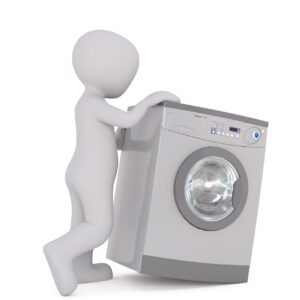Refrigerators are an essential appliance in our homes and businesses, keeping our food fresh and our beverages cold. However, like any other appliance, refrigerators can experience problems and malfunctions over time. This is where refrigerator troubleshooting comes in. Troubleshooting is the process of identifying and fixing problems in a refrigerator, ensuring that it continues to function properly.
The importance of refrigerator troubleshooting cannot be overstated. Identifying and fixing problems early on can prevent further damage to the refrigerator and save you from costly repairs or even having to replace the entire unit. By troubleshooting your refrigerator, you can also ensure that it continues to run efficiently, saving you money on energy bills.
Key Takeaways
- Understanding the basic components of a refrigerator is crucial for effective troubleshooting.
- Common refrigerator problems include faulty thermostats, clogged condenser coils, and malfunctioning compressors.
- Essential tools for refrigerator troubleshooting include a multimeter, thermometer, refrigerant pressure gauge, vacuum pump, and leak detector.
- The multimeter is the most important tool for refrigerator troubleshooting as it can measure voltage, resistance, and continuity.
- Safety is key when troubleshooting refrigerators, always unplug the appliance before starting any repairs.
Understanding the Basic Components of a Refrigerator
To effectively troubleshoot a refrigerator, it is important to have a basic understanding of its components and how they work together. The basic components of a refrigerator include the compressor, condenser coil, evaporator coil, expansion valve, and refrigerant.
The compressor is responsible for compressing the refrigerant gas, raising its temperature and pressure. The condenser coil then cools down the refrigerant gas, turning it into a liquid. The liquid refrigerant then flows through the expansion valve, which reduces its pressure and temperature. As it passes through the evaporator coil, the liquid refrigerant absorbs heat from the inside of the refrigerator, cooling down the air.
Understanding how these components work together is crucial for troubleshooting a refrigerator. If any of these components are not functioning properly, it can lead to problems such as inadequate cooling or excessive energy consumption.
Common Refrigerator Problems and their Causes
There are several common problems that can occur in a refrigerator, each with its own set of causes. Some of the most common problems include inadequate cooling, excessive frost buildup, water leakage, strange noises, and a malfunctioning ice maker.
Inadequate cooling can be caused by a variety of factors, such as a faulty compressor, a clogged condenser coil, or a malfunctioning thermostat. Excessive frost buildup is often caused by a faulty defrost system, which can be due to a defective defrost timer, defrost heater, or defrost thermostat. Water leakage can be caused by a clogged or frozen defrost drain, a faulty water inlet valve, or a damaged water line. Strange noises can be caused by a malfunctioning fan motor, a worn-out compressor, or loose components. A malfunctioning ice maker can be caused by a faulty water inlet valve, a clogged water line, or a defective ice maker module.
Identifying the root cause of the problem is crucial for effective troubleshooting. By understanding the causes of these common problems, you can narrow down the possible issues and take appropriate steps to fix them.
Essential Tools for Refrigerator Troubleshooting
Having the right tools is essential for effective refrigerator troubleshooting. Some of the essential tools include a multimeter, thermometer, refrigerant pressure gauge, vacuum pump, and leak detector.
A multimeter is perhaps the most important tool for refrigerator troubleshooting. It is used to measure electrical voltage, current, and resistance. This tool is crucial for diagnosing electrical problems in a refrigerator, such as faulty motors or switches.
A thermometer is another must-have tool for refrigerator troubleshooting. It is used to measure the temperature inside the refrigerator and freezer compartments. By testing the temperature, you can determine if the refrigerator is cooling properly or if there are any temperature fluctuations.
A refrigerant pressure gauge is used to check the refrigerant levels in the system. Low refrigerant levels can cause inadequate cooling and other problems. By using a pressure gauge, you can determine if the refrigerant levels are within the recommended range.
A vacuum pump is used for evacuating and charging the refrigerant system in a refrigerator. This tool is essential for removing air and moisture from the system before adding new refrigerant.
A leak detector is used to detect refrigerant leaks in the system. Refrigerant leaks can lead to inadequate cooling and other problems. By using a leak detector, you can locate and fix any leaks in the system.
Multimeter: The Most Important Tool for Refrigerator Troubleshooting
A multimeter is an essential tool for troubleshooting electrical problems in a refrigerator. It is used to measure electrical voltage, current, and resistance. By using a multimeter, you can diagnose and fix electrical issues in a refrigerator, such as faulty motors or switches.
To use a multimeter, you need to set it to the appropriate measurement range for the electrical parameter you are testing. For example, if you are measuring voltage, you need to set the multimeter to the voltage range. Then, you can connect the multimeter probes to the electrical component you are testing and read the measurement on the multimeter display.
When troubleshooting a refrigerator with a multimeter, it is important to follow safety guidelines. Make sure to disconnect the refrigerator from the power source before testing any electrical components. Also, be cautious when working with live wires and always wear protective gloves and goggles.
Thermometer: A Must-Have Tool for Refrigerator Temperature Testing

A thermometer is a must-have tool for testing the temperature of a refrigerator. It is used to measure the temperature inside the refrigerator and freezer compartments. By testing the temperature, you can determine if the refrigerator is cooling properly or if there are any temperature fluctuations.
To use a thermometer, simply place it inside the refrigerator or freezer compartment and wait for a few minutes until it reaches a stable reading. Then, you can read the temperature on the thermometer display.
Testing the temperature of a refrigerator is important for ensuring food safety and energy efficiency. If the temperature is too high, it can lead to food spoilage. If the temperature is too low, it can lead to excessive energy consumption.
Refrigerant Pressure Gauge: An Essential Tool for Checking Refrigerant Levels
A refrigerant pressure gauge is an essential tool for checking the refrigerant levels in a refrigerator. Low refrigerant levels can cause inadequate cooling and other problems. By using a pressure gauge, you can determine if the refrigerant levels are within the recommended range.
To use a refrigerant pressure gauge, you need to connect it to the service port on the refrigerant system. Then, you can read the pressure on the gauge display. The pressure reading should be compared to the manufacturer’s specifications to determine if the refrigerant levels are adequate.
Checking the refrigerant levels in a refrigerator is important for ensuring proper cooling and energy efficiency. If the refrigerant levels are too low, it can indicate a leak in the system that needs to be fixed.
Vacuum Pump: A Tool for Refrigerator System Evacuation and Charging
A vacuum pump is a tool used for evacuating and charging the refrigerant system in a refrigerator. This tool is essential for removing air and moisture from the system before adding new refrigerant.
To use a vacuum pump, you need to connect it to the service port on the refrigerant system. Then, you can turn on the vacuum pump and let it run for a specified period of time, usually around 30 minutes to an hour. This will create a vacuum in the system, removing any air and moisture.
After evacuating the system, you can then charge it with new refrigerant. This will ensure that the system operates efficiently and provides adequate cooling.
Leak Detector: A Tool for Detecting Refrigerant Leaks in the System
A leak detector is a tool used to detect refrigerant leaks in the system. Refrigerant leaks can lead to inadequate cooling and other problems. By using a leak detector, you can locate and fix any leaks in the system.
To use a leak detector, you need to turn it on and move it around the refrigerant system, paying close attention to areas where leaks are likely to occur, such as joints and connections. The leak detector will emit an audible or visual signal when it detects a refrigerant leak.
Detecting and fixing refrigerant leaks is important for ensuring proper cooling and preventing further damage to the system. It is also important for environmental reasons, as refrigerants can contribute to ozone depletion and climate change.
Tips for Safe and Effective Refrigerator Troubleshooting
When troubleshooting a refrigerator, it is important to follow safety guidelines and have a basic understanding of how a refrigerator works. Here are some tips for safe and effective refrigerator troubleshooting:
1. Disconnect the refrigerator from the power source before testing any electrical components.
2. Wear protective gloves and goggles when working with live wires or refrigerant.
3. Familiarize yourself with the basic components of a refrigerator and how they work together.
4. Use the appropriate tools for each troubleshooting task, such as a multimeter for electrical testing and a thermometer for temperature testing.
5. Follow the manufacturer’s instructions and specifications when troubleshooting a refrigerator.
6. Keep the refrigerator manual and any relevant documentation handy for reference.
7. If you are unsure about any aspect of refrigerator troubleshooting, consult a professional technician.
In conclusion, refrigerator troubleshooting is an essential skill for anyone who owns or works with refrigerators. By understanding the basic components of a refrigerator, common problems and their causes, and having the essential tools for troubleshooting, you can identify and fix problems early on, saving time and money in the long run. Remember to always follow safety guidelines and have a basic understanding of how a refrigerator works to ensure safe and effective troubleshooting.
If you’re looking for more information on refrigerator troubleshooting, be sure to check out the Our Blog section on 911 Appliance’s website. They have a wide range of articles that cover various topics related to appliance repair and maintenance. From tips on how to identify common refrigerator problems to step-by-step guides on DIY repairs, their blog is a valuable resource for homeowners. Whether you’re dealing with a faulty compressor or a leaking fridge, their articles can help you troubleshoot the issue and potentially save you money on costly repairs.
What Are the Essential Tools Needed for Mastering Refrigerator Basics and Troubleshooting?
When it comes to understanding refrigerator components and processes, having the essential tools is crucial for mastering basic maintenance and troubleshooting. Some key tools include a multimeter for checking electrical components, a flashlight for inspecting the interior, and a set of screwdrivers for accessing and repairing various parts.



